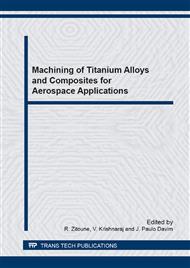[1]
Abrate S. Machining of composites. (1997). Mallick PK, editor. Composites engineering hand book. New York: Marcel Deckker Inc. pp.777-807.
Google Scholar
[2]
Chen WC. (1997). Some experimental investigations in the drilling of Carbon fibre reinforced composite laminations. Int. J. Mach. Tools and Mfr; 37(8):1097 -1108.
Google Scholar
[3]
Konig W. Cronjager L. Spur G. and Tonshoff HK. (1990). Machining of new materials. Annals of the CIRP; 39(2):673-680.
Google Scholar
[4]
Komanduri R. (1997). Machining of fibre reinforced composites, Mach. Sc. and Tech; 1(1):113-152.
Google Scholar
[5]
Bhatnagar N. Ramakrishnan, N. Naik N.K. Komanduri R. (1995). On the machining of fiber reinforced plastic composite laminates. Int. J. Mach. Tools Mfr; 35(5): 701-716.
DOI: 10.1016/0890-6955(95)93039-9
Google Scholar
[6]
Zitoune R. Collombet et al. (2005). Experiment-calculation comparison of the cutting conditions representative of the long fibre composite drilling phase. Comp. Sc. and Tech; 65(3-4):455-466.
DOI: 10.1016/j.compscitech.2004.09.028
Google Scholar
[7]
Hocheng H. and Dharan CKH. (1990). Delamination during drilling in composite laminates, Trans. ASME; 112: 236-239.
DOI: 10.1115/1.2899580
Google Scholar
[8]
Zitoune R. Collombet F. (2007). Numerical Prediction of the thrust force responsible of delamination during drilling of the long fibre composite structures. Comp. Part A. Apld. Sc. and Manuf; 38:858-86.
DOI: 10.1016/j.compositesa.2006.07.009
Google Scholar
[9]
Zitoune R. Collombet F. Hernaiz Lopez G. (2008). Experimental and analytical study of the influence of HexFit® glass fibre composite manufacturing process on delamination during drilling. Int. J. of Mach. and Machinablity of Matls. ; 3(3-4):326 - 342.
DOI: 10.1504/ijmmm.2008.020967
Google Scholar
[10]
Tsao CC. and Hocheng H. (2004). Taguchi analysis of delamination associated with various drill bits in drilling of composite materials. Int. J. of Mc Tools & Mafr. ; 44:1085-1090.
DOI: 10.1016/j.ijmachtools.2004.02.019
Google Scholar
[11]
Krishnaraj V. Vijayarangan S. and Paulo Davim. (2008). An experimental and statistical study on the effect of drill geometries on force and hole quality in drilling of glass fiber reinforced plastic. Int. J. of Materials and Product Technology; 32(2-3): 264-275.
DOI: 10.1504/ijmpt.2008.018985
Google Scholar
[12]
Mohan NS. Ramachandra A. and Kulkarni SM. (2005). Influence of process parameters on cutting force and torque during drilling of glass-fibre polyester reinforced composites. Com. Structures; 71:407-413.
DOI: 10.1016/j.compstruct.2005.09.039
Google Scholar
[13]
Davim JP. Pedro Reis and Conceicao Antonia. (2004). Experimental study of drilling glass fiber reinforced (GFRP) manufactured by hand lay-up, Comp. Science and Tech.; 64:289-297.
DOI: 10.1016/s0266-3538(03)00253-7
Google Scholar
[14]
List G. Nouari M. G´ehin D. Gomez S. Manaud P. Le Petitcorps Y. Girot F. (2005). Wear behaviour of cemented carbide tools in dry machining of aluminium alloy, Wear; 259:1177–1189.
DOI: 10.1016/j.wear.2005.02.056
Google Scholar
[15]
Nouari M. List G. Girot F. Ge´hin G. (2005). Effect of machining parameters and coating on wear mechanisms in dry drilling of aluminium alloys, Int. J. of Machine Tools & Mafr.; 45:1436–1442.
DOI: 10.1016/j.ijmachtools.2005.01.026
Google Scholar
[16]
Rivero A. Aramendi G. Herranz S. Lopez de Lacalle LN. (2006). An experimental investigation of the effect of coatings and cutting parameters on the dry drilling performance of aluminium alloys. Int J Adv Manuf Technol; 28: 1-11.
DOI: 10.1007/s00170-004-2349-3
Google Scholar
[17]
Batzer SA., Haan DM. Rao PD. Olson WW, Sutherland JW. (1998). Chip morphology and hole surface texture in the drilling of cast Aluminum alloys, J. of Materials Processing Tech.; 79:72–78.
DOI: 10.1016/s0924-0136(97)00324-5
Google Scholar
[18]
Brinksmeier E. and Janssen R. (2002). Drilling of multi-layer composite materials consisting of carbon fiber reinforced plastics (CFRP), Titanium and aluminum alloys, Annals of the CIRP; 51(1): 87-90.
DOI: 10.1016/s0007-8506(07)61472-3
Google Scholar
[19]
Ramulu M. Branson T. and Kim D. (2001). A study on the drilling of composite and titanium stacks. Composite Structures; 54:67-77.
DOI: 10.1016/s0263-8223(01)00071-x
Google Scholar
[20]
Kim D. and Ramulu M. (2004). Drilling process optimization for graphite/bismaleimide-titanium alloy stacks. Composite structures; 63(1):101- 114.
DOI: 10.1016/s0263-8223(03)00137-5
Google Scholar
[21]
Kim D. and Ramulu M. (2005). Machinability of Titanium/Graphite Hybrid Composites in Drilling. Trans. NAMRI/SME; 33:445-452.
Google Scholar
[22]
Kim D and Ramulu M. (2007). Study on the Drilling of Titanium/Graphite Hybrid Composites. J. Eng Mater Technol; 129(3):390-397.
Google Scholar
[23]
Roudge M. Cherif M. Cahuc O. Darnis P. and Danis M. (2008). Multi-layers materials. Qualitative approach of the process. Int. J. Materials Forming; 1(1):949-952.
DOI: 10.1007/s12289-008-0254-2
Google Scholar
[24]
Denkena B. Boehnke D. and Dege JH. (2008). Helical milling of CFRP–titanium layer compounds. CIRP Jl. of Manufacturing Science and Technology; l 1:64-69.
DOI: 10.1016/j.cirpj.2008.09.009
Google Scholar
[25]
Mike T. (2007). Composites Challenge Cutting Tools, Manufacturing Engineering; 138(4).
Google Scholar
[26]
Bagci E. and Ozcelik B. (2005). Analysis of temperature changes on the twist drill under different drilling conditions based on Taguchi method during dry drilling of Al. Int J Adv Manuf Tech.
DOI: 10.1007/S00170-004-2569-6
Google Scholar
[27]
Sreejith, P.S., Krishnamurthy, R., Malhotra, S.K., 2007. Effect of specific cutting pressure and temperature during machining of carbon/phenolic ablative composite using PCBN tools. Journal of Materials Processing Technology. 183, 88-95.
DOI: 10.1016/j.jmatprotec.2006.10.003
Google Scholar


